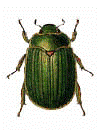Museum, University of Nebraska State
Document Type
Article
Date of this Version
October 1998
Abstract
Because the Sand Hills are, for the most part, a treeless landscape of grass-covered sand dunes, most of the insects are adapted to sandy habitats and a dry, continental climate, as well as to the kinds of plants and other animals that live there. Unlike most forest-adapted species, insects in the Sand Hills tolerate drier and windier conditions and greater solar radiation. They have also been successful in surviving the periodic fires that are so necessary for maintaining native grasslands. In fact, the mosaic of habitats partially created by fire has probably contributed to increased insect diversity in the Sand Hills.
With the introduction of row crops grown as monocultures (growing a single crop in the same place many years in a row), often with irrigation, a few insect species that formerly occurred in the Sand Hills in relatively low numbers now occasionally reach economically damaging levels (Wedberg and others, 1975). On the other hand, some formerly successful species have now disappeared from native prairie because of the disappeared from native prairie because of the severe disturbance caused by agriculture.



Comments
Published in An Atlas of the Sand Hills, edited by Ann S. Bleed and Charles A. Flowerday. Published by Conservation and Survey Division, Institute of Agriculture and Natural Resources, University of Nebraska-Lincoln. Third edition, 1998.